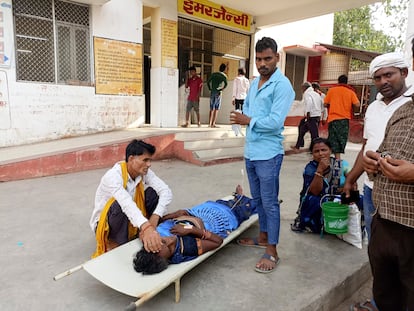Nearly 100 die as India struggles with a sweltering heat wave in two most populous states
The deaths happened in the northern state of Uttar Pradesh and eastern Bihar where authorities warned residents over 60 and others suffering various maladies to stay indoors during the daytime

At least 96 people died in two of India’s most populous states over the last several days, officials said Sunday, with swaths of the country reeling from a sweltering heat wave.
The deaths happened in the northern state of Uttar Pradesh and eastern Bihar where authorities warned residents over 60 and others suffering various maladies to stay indoors during the daytime.
All the fatalities in Uttar Pradesh, totaling 54, were reported in Ballia district, some 300 kilometers (200 miles) southeast of Lucknow, the state capital. Authorities found out most of those who passed away were over 60 years old and had preexisting health conditions, which may have been exacerbated by the intense heat.
S. K. Yadav, a medical officer in Ballia, said in the past three days, some 300 patients were admitted to the district hospital for various ailments aggravated by heat.
Due to the gravity of the situation, authorities canceled leave applications of medical personnel in Ballia and provided additional hospital beds in the emergency ward to accommodate the influx of patients.
Officials said most of the admitted patients are aged 60 and above, exhibiting symptoms of high fever, vomiting, diarrhea, breathing difficulties and heart-related issues.
R.S. Pathak, a resident of Ballia who lost his father on Saturday, said that he witnessed an increased flow of patients at the hospital’s emergency ward while attending to his father.
“This has never happened in Ballia. I have never seen people dying because of the heat in such large numbers,” he said. “People fear venturing out. The roads and markets are largely deserted.”
Ballia, along with central and eastern Uttar Pradesh, is currently grappling with oppressive heat.
On Sunday, the district experienced a maximum temperature of 43 degrees Celsius (109 degrees Fahrenheit), surpassing the normal range by five degrees. The relative humidity was recorded at 25%, intensifying the effect of the heat.
Atul Kumar Singh, a scientist from the India Meteorological Department, or IMD, said temperatures across the state were presently above normal. He added, “no relief is expected in the next 24 hours.”
The IMD issued an alert saying heat wave conditions would last until June 19 in parts of Uttar Pradesh.
The state’s health minister, Brijesh Pathak, said that they have opened an investigation into the cause of death of “so many people” in Ballia.
In eastern Bihar, scorching heat has engulfed most of the state, leading to 42 deaths in the past two days. Among the fatalities, 35 occurred at two hospitals in the state capital of Patna where over 200 patients suffering from diarrhea and vomiting were being treated.
Patna recorded a maximum temperature of 44.7 C Celsius (113 F) on Saturday.
The main summer months — April, May and June — are generally the hottest in most of India, before monsoon rains bring in cooler temperatures.
But temperatures have become more intense in the past decade. During heat waves, the country usually suffers severe water shortages, with tens of millions of its 1.4 billion people lacking running water.
A study by World Weather Attribution, an academic group that examines the source of extreme heat, found that a searing heat wave in April that struck parts of South Asia was made at least 30 times more likely by climate change.
In April, the heat caused the death of 13 people at a government event in India’s financial capital of Mumbai and prompted some states to close all schools for a week.
Sign up for our weekly newsletter to get more English-language news coverage from EL PAÍS USA Edition
Tu suscripción se está usando en otro dispositivo
¿Quieres añadir otro usuario a tu suscripción?
Si continúas leyendo en este dispositivo, no se podrá leer en el otro.
FlechaTu suscripción se está usando en otro dispositivo y solo puedes acceder a EL PAÍS desde un dispositivo a la vez.
Si quieres compartir tu cuenta, cambia tu suscripción a la modalidad Premium, así podrás añadir otro usuario. Cada uno accederá con su propia cuenta de email, lo que os permitirá personalizar vuestra experiencia en EL PAÍS.
¿Tienes una suscripción de empresa? Accede aquí para contratar más cuentas.
En el caso de no saber quién está usando tu cuenta, te recomendamos cambiar tu contraseña aquí.
Si decides continuar compartiendo tu cuenta, este mensaje se mostrará en tu dispositivo y en el de la otra persona que está usando tu cuenta de forma indefinida, afectando a tu experiencia de lectura. Puedes consultar aquí los términos y condiciones de la suscripción digital.
More information
Archived In
Últimas noticias
Most viewed
- Reinhard Genzel, Nobel laureate in physics: ‘One-minute videos will never give you the truth’
- Oona Chaplin: ‘I told James Cameron that I was living in a treehouse and starting a permaculture project with a friend’
- Pablo Escobar’s hippos: A serious environmental problem, 40 years on
- Why we lost the habit of sleeping in two segments and how that changed our sense of time
- Chevy Chase, the beloved comedian who was a monster off camera: ‘Not everyone hated him, just the people who’ve worked with him’










































